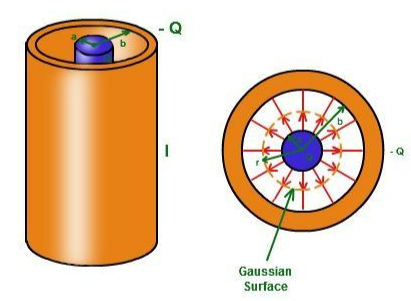
Before diving into the cylindrical capacitor formula , let's briefly review the fundamental concepts of capacitors. A capacitor consists of two conductive plates separated by a dielectric material. When a voltage is applied across the plates, an electric field is established in the dielectric, causing it to store electric charge.
Cylindrical Capacitor Structure

A cylindrical capacitor is designed with a cylindrical shape, where the two conductive plates are the inner and outer surfaces of the cylinder. The dielectric material occupies the space between these plates. This design offers some advantages in specific applications, such as in coaxial cables and certain sensors.
Cylindrical Capacitor Formula
The capacitance (C) of a cylindrical capacitor can be calculated using the following formula:

Where:
- - C is the capacitance.
- - ε is the permittivity of the dielectric material.
- - a is the radius of the inner conductor.
- - b is the radius of the outer conductor.
- - L is the length of the cylindrical capacitor.
This formula provides a way to determine the capacitance of a cylindrical capacitor based on its physical dimensions and the properties of the dielectric material.
Also Check - Kelvin To Celsius Formula
Applications of Cylindrical Capacitors
Cylindrical capacitors find applications in various fields, including:
- Coaxial Cables: Cylindrical capacitors are used in coaxial cables to maintain a controlled impedance along the length of the cable. This ensures that signals transmitted through the cable remain stable and do not suffer from distortion.
- Microwave Components: Cylindrical capacitors are utilized in various microwave components, such as resonators and filters. They help tune and adjust the frequencies of microwave signals, making them useful in radar systems and wireless communication devices.
- Sensors: Cylindrical capacitors can be incorporated into sensors for measuring physical quantities like pressure, humidity, and liquid levels. The change in capacitance due to the presence or displacement of a material can be used to detect and quantify these parameters.
- Power Factor Correction: Cylindrical capacitors are employed in power factor correction circuits to improve the power factor of electrical systems. They help reduce reactive power and enhance the overall efficiency of electrical distribution networks.
- High Voltage Applications: In high voltage applications, cylindrical capacitors with appropriate dielectric materials are used for energy storage, pulse shaping, and voltage stabilization. They play a vital role in pulsed power systems and particle accelerators.
- Capacitive Sensors in Touchscreens: In some touchscreen technologies, capacitive sensors are used to detect touch or proximity. Cylindrical capacitors are essential components in these sensors, allowing precise touch input recognition.
- Medical Devices: Cylindrical capacitors find applications in various medical devices, such as defibrillators and medical imaging equipment. They store energy and deliver controlled electrical pulses in life-saving situations.
- Energy Storage: In some applications, cylindrical capacitors are used for energy storage, particularly in situations where rapid energy discharge is required, such as in flash photography and strobe lighting.
- Radio Frequency (RF) Filters: Cylindrical capacitors are used in RF filters to tune and control the frequency response of RF circuits, making them suitable for applications in wireless communication systems.
- High-Quality Audio Equipment: Audiophiles often use high-quality capacitors, including cylindrical capacitors, in audio equipment to enhance the performance of amplifiers and other audio devices.
These are just a few examples of how cylindrical capacitors are utilized in various fields and applications. Their ability to store and release electrical energy, control impedance, and tune frequencies makes them versatile components in electronics and engineering.
Also Check - Gram Formula Mass
Some Uses:
- Coaxial Cable:
- Coaxial cables used in cable television and internet connections often contain cylindrical capacitors. These capacitors help maintain a consistent impedance along the cable's length, ensuring signal integrity and reducing interference.
- Microwave Resonators:
- Cylindrical capacitors are commonly used in microwave resonators. For instance, cylindrical cavity resonators in microwave ovens utilize these capacitors to generate and control microwave radiation for heating food.
- Pressure Sensors:
- Cylindrical capacitors can be integrated into pressure sensors. When pressure is applied to the sensor, it deforms, altering the spacing between the capacitor plates and changing the capacitance. This change is then used to measure pressure.
- Liquid Level Sensors:
- In applications where liquid levels need to be monitored, such as in industrial tanks or automotive fuel tanks, cylindrical capacitors are used. As the liquid level changes, it affects the capacitance of the sensor, allowing for level detection.
- Power Factor Correction Capacitors:
- Cylindrical capacitors are a common choice for power factor correction in electrical systems. They help improve power factor, reduce reactive power, and enhance the efficiency of power distribution networks.
- Energy Storage in Flash Units:
- Some high-intensity flash units in photography use cylindrical capacitors to store energy. When a photo is taken, the stored energy is discharged rapidly to create a bright flash of light.
- Touchscreen Technology:
- Capacitive touchscreens in smartphones and tablets utilize cylindrical capacitors to detect touch input. When you touch the screen, your finger's proximity changes the capacitance at specific points, enabling touch detection.
- Defibrillators:
- Medical defibrillators use cylindrical capacitors to store electrical energy. When a defibrillation shock is needed to restore a normal heart rhythm, the stored energy is discharged through the patient's chest.
- RF Filters:
- RF filters used in wireless communication systems incorporate cylindrical capacitors to tune and shape the frequency response of RF signals, allowing for the selection of specific frequencies.
- Particle Accelerators:
- In particle accelerators, cylindrical capacitors are essential components for storing and releasing energy to accelerate particles to high speeds. They play a crucial role in experimental physics research.
Also Check - Terminal Velocity Formula
These examples illustrate the diverse range of applications in which cylindrical capacitors are used, from electronics and telecommunications to industrial sensors and medical devices.
Cylindrical capacitors are an important component in various electronic applications, and understanding their formula and applications is essential for engineers and enthusiasts working with electrical circuits. By utilizing the cylindrical capacitor formula and considering its applications, you can design and optimize circuits more effectively.
Cylindrical Capacitor Formula FAQs
What is the purpose of a dielectric material in a cylindrical capacitor?
Why are cylindrical capacitors used in coaxial cables?
Can the capacitance of a cylindrical capacitor be increased by changing the dielectric material?
What happens if the voltage applied to a cylindrical capacitor exceeds its rated voltage?
How does the length of the cylindrical capacitor affect its capacitance?
What units are used to measure capacitance?
Can cylindrical capacitors store energy for a long time?
Are cylindrical capacitors commonly used in consumer electronics?










